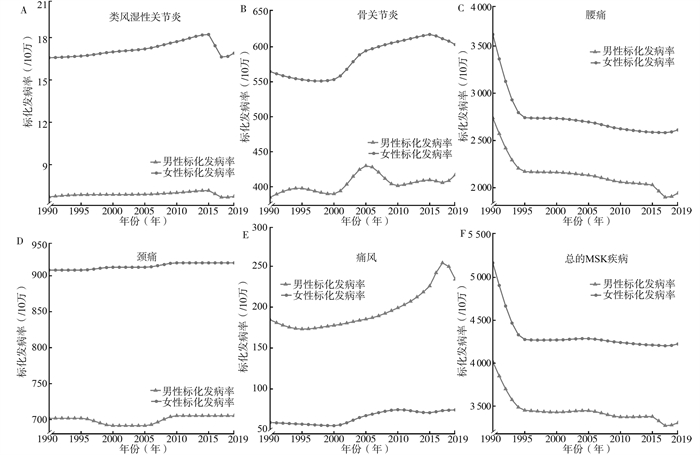-
摘要:
目的 分析1990-2019年我国肌肉骨骼疾病负担变化情况。 方法 基于全球健康数据交换库(Global Health Data Exchange, GHDx), 利用发病率、患病率和伤残调整寿命年(disability adjusted life year, DALY)等指标评价类风湿性关节炎、骨关节炎、腰痛、颈痛和痛风等肌肉骨骼疾病负担, 利用Joinpoint回归模型计算平均年度变化百分比(average annual percentage change, AAPC), 分析肌肉骨骼疾病负担变化趋势。 结果 2019年我国肌肉骨骼疾病标化发病率和DALY率分别为3 764.99/10万和1 585.44/10万, 较1990年分别下降17.80%和6.05%。除痛风外, 女性各类肌肉骨骼疾病的标化发病率和DALY率均高于男性。1990-2019年肌肉骨骼疾病标化发病率和DALY率总体呈下降趋势, AAPC分别为-0.68%和-0.22%, 其中腰痛下降最明显而痛风呈较明显的上升趋势。骨关节炎、腰痛和痛风可归因于高BMI的疾病负担持续增加, 腰痛可归因于吸烟和职业工效学因素的疾病负担下降, 痛风可归因于肾功能损伤的疾病负担上升。 结论 1990-2019年我国肌肉骨骼疾病负担总体呈下降趋势, 主要是由于腰痛的疾病负担明显下降, 类风湿性关节炎、骨关节炎、颈痛和痛风等疾病的防控形势依然严峻。 Abstract:Objective To analyze the past temporal trends of musculoskeletal disorders in China from 1990 to 2019. Methods Incidence, prevalence and disability adjusted life year (DALY) data for musculoskeletal disorders, including rheumatoid arthritis, osteoarthritis, low back pain, neck pain, and gout, were retrieved from the Global Health Data Exchange (GHDx), to evaluate the disease burden.The joinpoint regression model was utilized to analyze the trend of these disorders from 1990 to 2019, with the trends measured using the average annual percentage change (AAPC). Results In 2019, the age-standardized incidence rate for musculoskeletal disorders in China was 3 764.99/100 000 and the DALY rate was 1 585.44/100 000.These rates decreased by 17.80% and 6.05%, respectively, compared with 1990.The age-standardized rates of incidence and DALY for all musculoskeletal disorder categories were higher in women, except for gout.From 1990 to 2019, the age-standardized rates of incidence and DALY were decreased for total musculoskeletal disorders, with AAPCs of-0.68% and-0.22%, respectively.The rates for low back pain exhibited a significant decrease, but those for gout markedly increased.The disease burden attributable to high body mass index (BMI) for osteoarthritis, low back pain, and gout demonstrated a declining trend.However, the burden attributed to smoking and occupational ergonomic factors for low back pain decreased, while that attributed to impaired kidney function for gout increased. Conclusions From 1990 to 2019, the overall disease burden of musculoskeletal disorders in China has decreased, primarily due to the decline in low back pain.Nevertheless, the burden caused by other musculoskeletal conditions, such as rheumatoid arthritis, osteoarthritis, neck pain, and gout, remains a significant public health challenge. -
Key words:
- Musculoskeletal disorders /
- Incidence /
- Disease burden /
- Risk factors
-
表 1 1990和2019年我国MSK疾病发病、患病和疾病负担情况
Table 1. The morbidity, prevalence and burden of MSK disorders in China in 1990 and 2019
疾病 年份/年 发病 患病 DALY 人数/10万 粗率/10万-1 标化率/10万-1 人数/10万 粗率/10万-1 标化率/10万-1 人年数/10万人年 粗率/10万-1 标化率/10万-1 占比/% 类风湿性关节炎 1990 1.25 10.57 11.45 20.12 169.99 206.10 3.70 31.29 39.01 2.11 2019 2.23 15.64 11.74 43.09 302.98 216.89 7.74 54.44 39.47 2.59 骨关节炎 1990 45.91 387.85 472.53 517.60 4 372.84 5 880.58 18.19 153.70 206.38 10.39 2019 106.81 750.96 509.84 1 328.07 9 337.15 6 330.06 47.25 332.19 224.78 15.78 髋关节炎 1990 0.82 6.89 8.29 15.04 127.03 172.51 0.48 4.09 5.49 0.28 2019 2.43 17.09 11.42 47.87 336.56 234.09 1.53 10.76 7.46 0.51 膝关节炎 1990 36.84 311.22 377.20 425.71 3 596.48 4 797.01 13.65 115.33 152.74 7.79 2019 84.26 592.38 402.30 1 081.20 7 601.51 5 125.46 34.65 243.59 163.70 11.57 手关节炎 1990 4.38 37.04 45.66 69.90 590.52 828.04 2.22 18.78 26.08 1.27 2019 10.98 77.19 52.71 196.37 1 380.63 953.81 6.23 43.81 30.12 2.08 其他骨关节炎 1990 3.87 32.70 41.37 57.84 488.65 702.35 1.84 15.51 22.07 1.05 2019 9.14 64.29 43.41 152.80 1 074.31 745.83 4.84 34.03 23.50 1.62 腰痛 1990 332.29 2 807.29 3 174.26 752.98 6 361.37 7 245.29 85.53 722.56 815.20 48.82 2019 401.58 2 823.38 2 280.67 913.39 6 421.72 5 134.73 103.34 726.55 579.05 34.52 颈痛 1990 89.31 754.49 800.68 378.51 3 197.72 3 528.35 38.14 322.22 352.84 21.77 2019 148.88 1 046.72 809.91 679.66 4 778.43 3 571.96 67.92 477.52 358.13 22.69 痛风 1990 11.82 99.86 121.37 58.64 495.42 624.53 1.87 15.84 19.72 1.07 2019 30.41 213.82 152.83 161.61 1 136.24 803.31 5.10 35.89 25.33 1.71 其他MSK疾病 1990 ― ― ― 300.16 2 535.85 2 784.68 27.75 234.48 254.44 15.84 2019 ― ― ― 756.15 5 316.23 3 940.36 67.98 477.95 358.67 22.71 总的MSK疾病 1990 480.58 4 060.06 4 580.28 1 732.94 14 640.24 17 016.45 175.19 1 480.08 1 687.59 100.00 2019 689.91 4 850.53 3 764.99 3 244.69 22 812.18 16 887.63 299.34 2 104.54 1 585.44 100.00 注:1. DALY: 伤残调整寿命年。2. MSK: 肌肉骨骼。3. “―”代表GBD数据库未报告。 表 2 1990―2019年我国MSK疾病标化发病率及DALY率变化情况
Table 2. The trend of the age-standardized rates of incidence and DALY for MSK disorders in China from 1990 to 2019
疾病 标化发病率 标化DALY率 AAPC/% 95% CI/% P值 AAPC/% 95% CI/% P值 类风湿性关节炎 0.08 0.05~0.11 < 0.001 0.03 -0.13~0.18 0.715 骨关节炎 0.25 0.19~0.31 < 0.001 0.28 0.22~0.34 < 0.001 腰痛 -1.16 -1.23~-1.08 < 0.001 -1.20 -1.28~-1.12 < 0.001 颈痛 0.04 0.04~0.04 < 0.001 0.05 0.05~0.06 < 0.001 痛风 0.83 0.74~0.92 < 0.001 0.90 0.81~0.99 < 0.001 总MSK疾病 -0.68 -0.72~-0.63 < 0.001 -0.22 -0.28~-0.16 < 0.001 注:1. MSK肌肉骨骼。2. AAPC平均年度变化百分比。3. DALY:伤残调整寿命年。 表 3 1990―2019年我国肌肉骨骼疾病危险因素归因疾病负担变化趋势
Table 3. The trend of the attributable burden of risk factors for MSK disorders in China from 1990 to 2019
疾病 危险因素 归因标化DALY率/10万-1 AAPC/% 95% CI/% P值 1990年 2019年 类风湿性关节炎 吸烟 4.56 4.46 -0.16 -0.37~0.05 0.138 骨关节炎 高BMI 10.94 25.99 3.03 2.88~3.18 < 0.001 腰痛 高BMI 15.35 23.37 1.45 1.32~1.57 < 0.001 职业工效学因素 310.13 155.30 -2.37 -2.47~-2.27 < 0.001 吸烟 132.56 86.48 -1.47 -1.59~-1.35 < 0.001 痛风 高BMI 1.94 5.64 3.80 3.64~3.95 < 0.001 肾功能损伤 1.71 2.44 1.28 1.11~1.45 < 0.001 总MSK疾病 高BMI 28.23 55.00 2.32 2.17~2.47 < 0.001 肾功能损伤 1.71 2.44 1.28 1.11~1.45 < 0.001 职业工效学因素 310.13 155.30 -2.37 -2.47~-2.27 < 0.001 吸烟 137.13 90.94 -1.41 -1.53~-1.3 < 0.001 注:1. MSK:肌肉骨骼。2. DALY:伤残调整寿命年。3. AAPC:平均年度变化百分比。 -
[1] Sebbag E, Felten R, Sagez F, et al. The world-wide burden of musculoskeletal diseases: a systematic analysis of the World Health Organization Burden of Diseases Database[J]. Ann Rheum Dis, 2019, 78(6): 844-848. DOI: 10.1136/annrheumdis-2019-215142. [2] Briggs AM, Woolf AD, Dreinhöfer K, et al. Reducing the global burden of musculoskeletal conditions[J]. Bull World Health Organ, 2018, 96(5): 366-368. DOI: 10.2471/blt.17.204891. [3] Wolf J, França EB, Assunção A. The burden of low back pain, rheumatoid arthritis, osteoarthritis, and gout and their respective attributable risk factors in Brazil: results of the GBD 2017 study[J]. Rev Soc Bras Med Trop, 2022, 55(suppl 1): e0285. DOI: 10.1590/0037-8682-0285-2021. [4] Jin Z, Wang D, Zhang H, et al. Incidence trend of five common musculoskeletal disorders from 1990 to 2017 at the global, regional and national level: results from the global burden of disease study 2017[J]. Ann Rheum Dis, 2020, 79(8): 1014-1022. DOI: 10.1136/annrheumdis-2020-217050. [5] Zhou M, Wang H, Zeng X, et al. Mortality, morbidity, and risk factors in China and its provinces, 1990-2017: a systematic analysis for the Global Burden of Disease Study 2017[J]. Lancet, 2019, 394(10204): 1145-1158. DOI: 10.1016/s0140-6736(19)30427-1. [6] Woolf AD, Akesson K. Understanding the burden of musculoskeletal conditions. The burden is huge and not reflected in national health priorities[J]. BMJ, 2001, 322(7294): 1079-1080. DOI: 10.1136/bmj.322.7294.1079. [7] GBD 2019 Diseases and Injuries Collaborators. Global burden of 369 diseases and injuries in 204 countries and territories, 1990-2019: a systematic analysis for the Global Burden of Disease Study 2019[J]. Lancet, 2020, 396(10258): 1204-1222. DOI: 10.1016/s0140-6736(20)30925-9. [8] GBD 2019 Risk Factors Collaborators. Global burden of 87 risk factors in 204 countries and territories, 1990-2019: a systematic analysis for the Global Burden of Disease Study 2019[J]. Lancet, 2020, 396(10258): 1223-1249. DOI: 10.1016/s0140-6736(20)30752-2. [9] Safiri S, Kolahi AA, Cross M, et al. Global, regional, and national burden of other musculoskeletal disorders 1990-2017: results from the Global Burden of Disease Study 2017[J]. Rheumatology (Oxford), 2021, 60(2): 855-865. DOI: 10.1093/rheumatology/keaa315. [10] 黄钊慰, 薛明劲, 胡雨迪, 等. 1990―2019年中国结直肠癌归因于各类危险因素的疾病负担分析与模型预测[J]. 中华疾病控制杂志, 2022, 26(1): 7-13. DOI: 10.16462/j.cnki.zhjbkz.2022.01.002.Huang ZW, Xue MJ, Hu YD, et al. Analysis and model prediction of disease burden attributable to various risk factors for colorectal cancer in China from 1990 to 2019[J]. Chin J Dis Control Prev, 2022, 26(1): 7-13. DOI: 10.16462/j.cnki.zhjbkz.2022.01.002. [11] Liu S, Wang B, Fan S, et al. Global burden of musculoskeletal disorders and attributable factors in 204 countries and territories: a secondary analysis of the Global Burden of Disease 2019 study[J]. BMJ Open, 2022, 12(6): e062183. DOI: 10.1136/bmjopen-2022-062183. [12] Jin Z, Feng X, Wang D, et al. Global, regional and national trends in sex- and age-specific disability-adjusted life years of musculoskeletal disorders, 1990-2019[J]. Rheumatology (Oxford), 2022, 61(7): 2978-2986. DOI: 10.1093/rheumatology/keab804. [13] Wolf JM, Cannada L, Van Heest AE, et al. Male and female differences in musculoskeletal disease[J]. J Am Acad Orthop Surg, 2015, 23(6): 339-347. DOI: 10.5435/jaaos-d-14-00020. [14] 何彩丽, 程宁, 荣右明, 等. 金昌队列人群痛风发病危险因素的Cox回归分析[J]. 中华流行病学杂志, 2017, 38(7): 897-901. DOI: 10.3760/cma.j.issn.0254-6450.2017.07.010.He CL, Cheng N, Rong YM, et al. Risk factors of gout in Jinchang cohort: a Cox regression analysis[J]. Chin J Epidemiol, 2017, 38(7): 897-901. DOI: 10.3760/cma.j.issn.0254-6450.2017.07.010. [15] Roddy E, Zhang W, Doherty M. The changing epidemiology of gout[J]. Nat Clin Pract Rheumatol, 2007, 3(8): 443-449. DOI: 10.1038/ncprheum0556. [16] Song P, Wang H, Xia W, et al. Prevalence and correlates of hyperuricemia in the middle-aged and older adults in China[J]. Sci Rep, 2018, 8(1): 4314. DOI: 10.1038/s41598-018-22570-9. [17] Xia Y, Wu Q, Wang H, et al. Global, regional and national burden of gout, 1990-2017: a systematic analysis of the Global Burden of Disease Study[J]. Rheumatology (Oxford), 2020, 59(7): 1529-1538. DOI: 10.1093/rheumatology/kez476. [18] Tang YM, Zhang L, Zhu SZ, et al. Gout in China, 1990-2017: the Global Burden of Disease Study 2017[J]. Public Health, 2021, 191: 33-38. DOI: 10.1016/j.puhe.2020.06.029. [19] 国家卫生健康委疾病预防控制局. 中国居民营养与慢性病状况报告(2020年)[M]. 北京: 人民卫生出版社, 2021: 42.Bureau of Disease Control and Prevention of the National Health Commission of the People's Republic of China. Report on Chinese residents' nutrition and chronic diseases (2020)[M]. Beijing: People's Medical Publishing House, 2021: 42. [20] Wang Y, Zhao L, Gao L, et al. Health policy and public health implications of obesity in China[J]. Lancet Diabetes Endocrinol, 2021, 9(7): 446-461. DOI: 10.1016/s2213-8587(21)00118-2. -





 下载:
下载:



